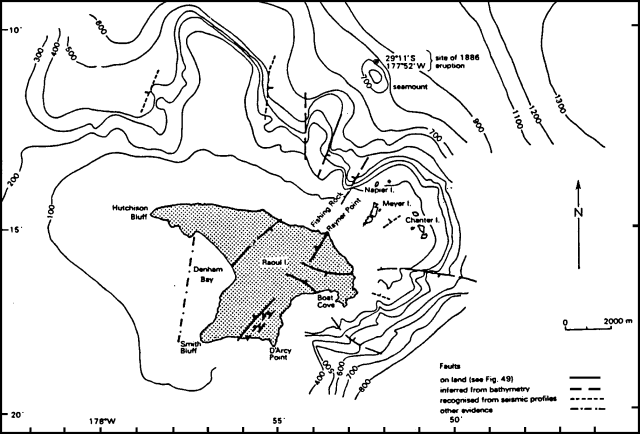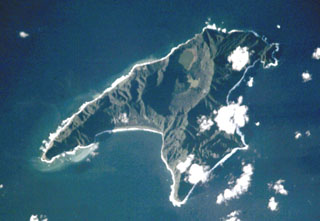Report on Raoul Island (New Zealand) — March 1987
Scientific Event Alert Network Bulletin, vol. 12, no. 3 (March 1987)
Managing Editor: Lindsay McClelland.
Raoul Island (New Zealand) Possible steam emission
Please cite this report as:
Global Volcanism Program, 1987. Report on Raoul Island (New Zealand) (McClelland, L., ed.). Scientific Event Alert Network Bulletin, 12:3. Smithsonian Institution. https://doi.org/10.5479/si.GVP.SEAN198703-242030
Raoul Island
New Zealand
29.27°S, 177.92°W; summit elev. 516 m
All times are local (unless otherwise noted)
A possible minor eruption occurred at about 1000 on 25 March, when apparent steam emission, resembling whales spouting, was reported. A similar event occurred in approximately the same location some months previously but was not reported because activity was attributed to whales. An observer on Raoul Island, Peter Fisher, noted a possible thickening of the seismogram trace and remarked that whales are not normally found in area waters at this time of year.
The eruptive activity was an estimated 7 km NNE (10-20° E of N) of the meteorological station on the central N coast of Raoul Island. The activity was very close to a seamount (figure 1) and the site of floating pumice and upwelling reported in 1886, 8 km NNE of Raoul (Lloyd and Nathan, 1981, p. 62-63).
 |
Figure 1. Bathymetric map and structure of Raoul Island, compiled from surveys of HMNZS Lachlan and RV Vulkanolog (Lloyd and Nathan, 1981). Isobaths are in meters. |
Reference. Lloyd, E.F. and Nathan, S., 1981, Geology and tephrochronology of Raoul Island, Kermadec Group, New Zealand: New Zealand Geological Survey Bulletin, no. 95, 105 p.
Geological Summary. Anvil-shaped Raoul Island is the largest and northernmost of the Kermadec Islands. During the past several thousand years volcanism has been dominated by dacitic explosive eruptions. Two Holocene calderas exist, the older of which cuts the center the island and is about 2.5 x 3.5 km wide. Denham caldera, formed during a major dacitic explosive eruption about 2200 years ago, truncated the W side of the island and is 6.5 x 4 km wide. Its long axis is parallel to the tectonic fabric of the Havre Trough that lies W of the volcanic arc. Historical eruptions during the 19th and 20th centuries have sometimes occurred simultaneously from both calderas, and have consisted of small-to-moderate phreatic eruptions, some of which formed ephemeral islands in Denham caldera. An unnamed submarine cone, one of several located along a fissure on the lower NNE flank, has also erupted during historical time, and satellitic vents are concentrated along two parallel NNE-trending lineaments.
Information Contacts: J. Latter, DSIR Geophysics, Wellington.

